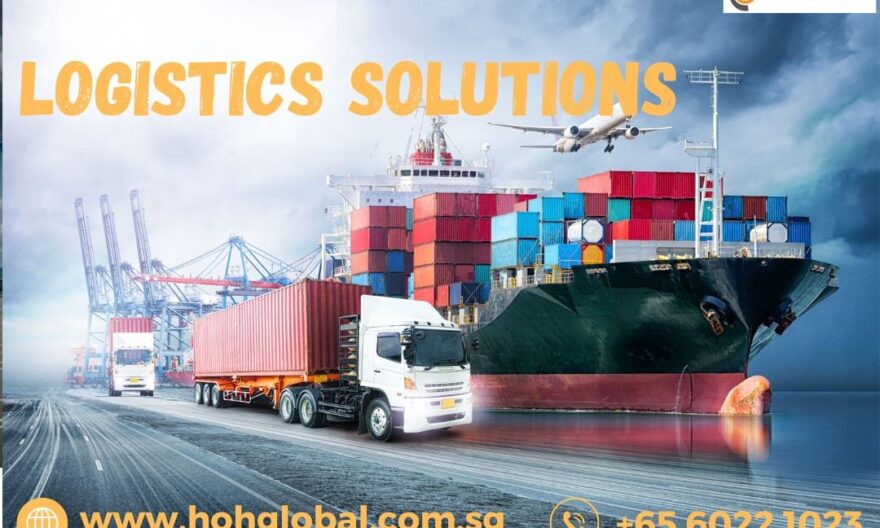
Every day, businesses and people launch goods on journeys across the world. Some shipments must dash to their destination, while others cruise at a slower pace to save money. Logistics solutions help businesses decide the best way to ship. Air freight rockets through the sky, making it perfect for urgent items like medicine and fresh food. Sea freight rides the waves, carrying massive loads at a much lower cost.
Choosing the right shipping method hinges on budget, speed, and cargo size. Understanding how each works helps businesses sharpen their logistics solutions and make smart choices. Let’s plunge into the details and find the best option for your shipping needs!
What is Freight Solution?
Freight solutions mean moving goods from one place to another. Trucks, planes, and ships carry products for businesses and individuals. Two popular methods for sending goods internationally are air freight and sea freight.
Each method has strong points and weak spots. Picking the right one depends on delivery time, cargo size, and budget.
Understanding Air Freight and Sea Freight
What is Air Freight Services?
Air freight services lifts goods into the sky and speeds them across the world. Cargo travels in special planes or in storage areas of passenger planes. This method is the fastest way to send goods across long distances.
Businesses choose air freight for products that must arrive quickly. Perishable food, medical supplies, and valuable electronics often fly to their destinations.
What is Sea Freight?
Sea freight loads cargo onto massive ships and sails it across oceans. Containers hold all types of goods, making this method ideal for bulk shipments.
Ships travel much slower than planes, but they carry large loads at lower costs. Businesses use sea freight to move furniture, machinery, and raw materials.
Speed Showdown: Which Moves Faster?
Air Freight Services: The Quickest Way to Deliver
Air freight rushes packages across the world in days instead of weeks. Most international shipments land in 1–7 days, depending on the distance and customs checks.
Why Air Freight Outruns Other Methods
- Direct flights slash travel time – Planes soar straight to destinations.
- Frequent departures keep shipments moving – Many flights take off daily.
- Swift processing speeds up delivery – Airports load, check, and clear goods quickly.
If a business must ship emergency supplies or urgent orders, air freight is the best choice.
Sea Freight: Steady but Slow
Sea freight moves at a measured pace. Ships take 20–60 days to reach their destination, depending on the route and port traffic. Unlike planes, ships must stop at several points along the way, slowing the journey.
Why Sea Freight Takes Longer
- Ships cruise at a steady but sluggish speed – They take their time crossing oceans.
- Loading and unloading require patience – Ports handle massive cargo loads carefully.
- Storms and congestion cause delays – Rough seas and busy docks slow down schedules.
Businesses that don’t mind waiting can pick sea freight and save money.
Speed Verdict: Air Freight Wins
For fast deliveries, nothing beats air freight. It zips packages to their destinations, making it the top choice for time-sensitive shipments. However, when time isn’t a problem, sea freight offers a solid alternative.
Cost Comparison: Which Saves More Money?
Air Freight: Pricey but Quick
Air freight demands more money because it relies on expensive fuel, fast handling, and weight-based pricing. Small, lightweight packages cost less, but heavy shipments drain the budget fast.
Why Air Freight Costs More?
- Jet fuel burns money – Planes consume costly fuel.
- Weight-based charges add up – Heavier cargo raises the bill.
- Airport fees pile on costs – Storing, loading, and checking cargo aren’t free.
Businesses choose air freight when speed matters more than cost.
Sea Freight: The Wallet-Friendly Choice
Sea freight trims shipping costs by carrying massive loads at once. Businesses moving bulk goods save money by filling entire containers.
Why Sea Freight Keeps Costs Low?
- Ships haul huge amounts of cargo – More goods mean lower costs per unit.
- Flat-rate container pricing saves money – Businesses pay for space, not weight.
- Fuel efficiency cuts expenses – Ships use fuel wisely over long trips.
Cost Verdict: Sea Freight Wins
For businesses looking to save money, sea freight delivers the best value. Air freight speeds up shipping, but its high price makes it impractical for large shipments.
Other Factors to Consider
Cargo Size and Weight
- Air freight carries small, lightweight goods.
- Sea freight hauls heavy, oversized, or bulk items.
Type of Products
- Air freight suits perishables, electronics, and luxury goods.
- Sea freight works for raw materials, industrial machines, and furniture.
Customs and Rules
- Air freight follows strict regulations but clears customs fast.
- Sea freights face fewer restrictions but take longer to process.
Environmental Impact
- Air freight leaves a larger carbon footprint.
- Sea freight causes less pollution and consumes fuel wisely.
Picking the Right Freight Method
When to Choose Air Freight
- Deliveries must arrive quickly.
- Goods are small, valuable, or perishable.
- Businesses can afford higher costs.
When to Choose Sea Freight?
- Shipments involve large or heavy cargo.
- Cutting costs matters more than speed.
- The delivery timeline allows for longer transit.
When Should Businesses Pick Sea Freight?
Sea freight moves goods across oceans at a steady pace. It works best for businesses that need:
- Low-cost shipping for bulk orders – Companies save big by sending huge shipments at once. The more they send, the less they pay per item.
- Heavy cargo that air freight won’t lift – Machines, vehicles, and building materials sit strong on ships, where weight doesn’t cause trouble.
- Long-distance shipping when time doesn’t matter – If businesses can wait, sea freight glides ahead as the smartest budget-friendly choice.
- A greener way to ship – Ships sail with care for the planet, producing fewer carbon emissions than planes.
- Safe transport for strong, non-urgent goods – Furniture, canned foods, and textiles nestle safely in sturdy containers, ready for long trips.
Mixing Air and Sea Freight for Better Shipping
Many companies combine both shipping methods for better efficiency.
Air-Sea Hybrid Shipping
- Air freight handles urgent or high-value goods.
- Sea freight carries bulk goods more cheaply.
- This mix reduces costs while keeping delivery times reasonable.
Multi-Mode Freight Solutions
- Some companies use trucks, trains, ships, and planes together.
- Warehouses help speed up shipments while keeping costs low.
How to Choose the Best Freight Solution for Your Business
Every business ships goods in its own way. Picking the right method keeps deliveries smooth and costs under control. Here’s how to decide:
Shipment Size
- Small, light packages soar best by air, reaching their destination quickly.
- Bulky, heavy cargo sails smoothly by sea, packed safely into large containers.
Budget
- Air freight suits businesses that can spend more for speed, making sure urgent goods arrive fast.
- Sea freight helps companies save money, offering a smart way to move big shipments at a lower cost.
Delivery Time
- Air freight dashes across the sky, delivering goods in just a few days.
- Sea freight glides steadily, taking longer but working well for businesses that don’t need fast delivery.
Destination
- Air freight lands deep inland, reaching cities far from the coast.
- Sea freight docks at ports, where trucks or trains carry goods the rest of the way.
Other Considerations
- Fragile and expensive goods fly safely with air freight, avoiding rough handling.
- Eco-friendly businesses pick sea freight since ships tread more gently on the environment.
Final Verdict
Air and sea freight work in different ways to move goods around the world. Air freight dashes ahead, making it the best pick for urgent items like fresh food, medicine, and valuable goods. Sea freight drifts steadily, carrying big and heavy loads at a lower cost.
Many businesses mix both methods to get the best results. They send small, urgent packages by air and haul bulk shipments by sea. Picking the right way to ship saves money and keeps things moving smoothly, helping businesses deliver goods fast and smart.



